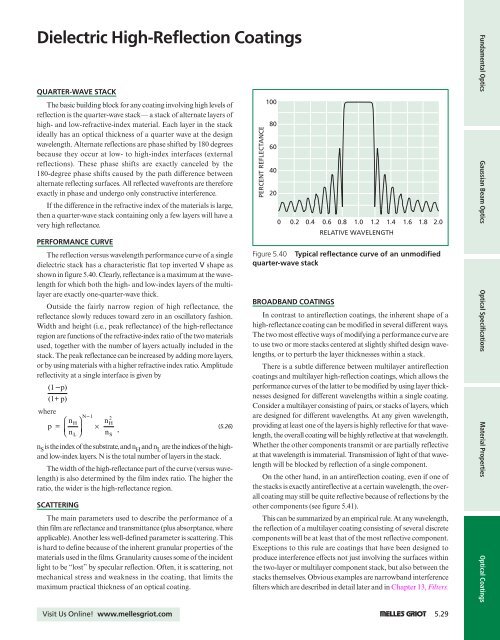Optical Coatings
Optical Coatings
Optical Coatings
You also want an ePaper? Increase the reach of your titles
YUMPU automatically turns print PDFs into web optimized ePapers that Google loves.
Dielectric High-Reflection <strong>Coatings</strong><br />
QUARTER-WAVE STACK<br />
The basic building block for any coating involving high levels of<br />
reflection is the quarter-wave stack— a stack of alternate layers of<br />
high- and low-refractive-index material. Each layer in the stack<br />
ideally has an optical thickness of a quarter wave at the design<br />
wavelength. Alternate reflections are phase shifted by 180 degrees<br />
because they occur at low- to high-index interfaces (external<br />
reflections). These phase shifts are exactly canceled by the<br />
180-degree phase shifts caused by the path difference between<br />
alternate reflecting surfaces. All reflected wavefronts are therefore<br />
exactly in phase and undergo only constructive interference.<br />
If the difference in the refractive index of the materials is large,<br />
then a quarter-wave stack containing only a few layers will have a<br />
very high reflectance.<br />
PERFORMANCE CURVE<br />
The reflection versus wavelength performance curve of a single<br />
dielectric stack has a characteristic flat top inverted V shape as<br />
shown in figure 5.40. Clearly, reflectance is a maximum at the wavelength<br />
for which both the high- and low-index layers of the multilayer<br />
are exactly one-quarter-wave thick.<br />
Outside the fairly narrow region of high reflectance, the<br />
reflectance slowly reduces toward zero in an oscillatory fashion.<br />
Width and height (i.e., peak reflectance) of the high-reflectance<br />
region are functions of the refractive-index ratio of the two materials<br />
used, together with the number of layers actually included in the<br />
stack. The peak reflectance can be increased by adding more layers,<br />
or by using materials with a higher refractive index ratio. Amplitude<br />
reflectivity at a single interface is given by<br />
(14p)<br />
(1+ p)<br />
where<br />
⎛<br />
p = n ⎜<br />
⎝ n<br />
H<br />
L<br />
n S is the index of the substrate, and n H and n L are the indices of the highand<br />
low-index layers. N is the total number of layers in the stack.<br />
The width of the high-reflectance part of the curve (versus wavelength)<br />
is also determined by the film index ratio. The higher the<br />
ratio, the wider is the high-reflectance region.<br />
SCATTERING<br />
N41<br />
2<br />
⎞ nH<br />
⎟ × (5.26)<br />
⎠ n ,<br />
S<br />
The main parameters used to describe the performance of a<br />
thin film are reflectance and transmittance (plus absorptance, where<br />
applicable). Another less well-defined parameter is scattering. This<br />
is hard to define because of the inherent granular properties of the<br />
materials used in the films. Granularity causes some of the incident<br />
light to be “lost” by specular reflection. Often, it is scattering, not<br />
mechanical stress and weakness in the coating, that limits the<br />
maximum practical thickness of an optical coating.<br />
PERCENT REFLECTANCE<br />
100<br />
80<br />
60<br />
40<br />
20<br />
0 0.2 0.4 0.6 0.8 1.0 1.2 1.4 1.6 1.8 2.0<br />
BROADBAND COATINGS<br />
RELATIVE WAVELENGTH<br />
Figure 5.40 Typical reflectance curve of an unmodified<br />
quarter-wave stack<br />
In contrast to antireflection coatings, the inherent shape of a<br />
high-reflectance coating can be modified in several different ways.<br />
The two most effective ways of modifying a performance curve are<br />
to use two or more stacks centered at slightly shifted design wavelengths,<br />
or to perturb the layer thicknesses within a stack.<br />
There is a subtle difference between multilayer antireflection<br />
coatings and multilayer high-reflection coatings, which allows the<br />
performance curves of the latter to be modified by using layer thicknesses<br />
designed for different wavelengths within a single coating.<br />
Consider a multilayer consisting of pairs, or stacks of layers, which<br />
are designed for different wavelengths. At any given wavelength,<br />
providing at least one of the layers is highly reflective for that wavelength,<br />
the overall coating will be highly reflective at that wavelength.<br />
Whether the other components transmit or are partially reflective<br />
at that wavelength is immaterial. Transmission of light of that wavelength<br />
will be blocked by reflection of a single component.<br />
On the other hand, in an antireflection coating, even if one of<br />
the stacks is exactly antireflective at a certain wavelength, the overall<br />
coating may still be quite reflective because of reflections by the<br />
other components (see figure 5.41).<br />
This can be summarized by an empirical rule. At any wavelength,<br />
the reflection of a multilayer coating consisting of several discrete<br />
components will be at least that of the most reflective component.<br />
Exceptions to this rule are coatings that have been designed to<br />
produce interference effects not just involving the surfaces within<br />
the two-layer or multilayer component stack, but also between the<br />
stacks themselves. Obvious examples are narrowband interference<br />
filters which are described in detail later and in Chapter 13, Filters.<br />
Fundamental Optics Gaussian Beam Optics <strong>Optical</strong> Specifications Material Properties <strong>Optical</strong> <strong>Coatings</strong><br />
Visit Us Online! www.mellesgriot.com 1 5.29
















